A Private Tour today, down in the Brecks. It was a misty start, but it was meant to brighten up during the day, or at least that is what we had been told. We started at St Helens. It was a bit of a long shot, but with the Lesser Spotted Woodpecker having been seen a couple of times here in the last few weeks, it seemed like a good place to look first.
A Grey Wagtail was feeding down on the river, on an island of trapped vegetation around a fallen tree. We had a quick look at it in the scope. When it flew, we realised there were two of them, and then a third flew up from the bank too. We stood for a while by the footbridge and two of the Grey Wagtails kept coming back, the male landing a couple of times briefly on the handrail and even perching in the tree above our heads singing at one point.
We walked over the river into Suffolk. We could hear Siskins twittering in the trees above us, and several Redwings flew along the edge of the trees by the paddocks. We continued further on to get a better look at them, and realised there were actually quite a few down on the grass. The longer we stood there, the more came out of the trees, until there were at least 100 Redwings spread across the paddocks, feeding on the short grass. We were just trying to count them when a couple of Carrion Crows flew over calling loudly and all the Redwings fled back to the trees. We could hear them chattering away there, but they seemed reluctant to come out again. A Green Woodpecker called from the pines beyond, but there was no sign of any other woodpeckers here.
 Redwing – a flock of at least 100 were in the paddocks
Redwing – a flock of at least 100 were in the paddocks
We headed back to the village and walked up towards the church. A Goldcrest was singing nearby and another was feeding in a small conifer by the path but the churchyard itself was rather quiet. It was still very misty, particularly so close to the river, and cold with no sign of the sun. A Great Spotted Woodpecker called as it flew overhead. Later, we could see three flying through the tops of the trees by the river and one perched up where we could see it.
We had been hanging on hoping to see some signs of the mist burning off before heading deeper into the forest, but in the end we decided to make our way over there anyway. The walk out along the ride was quiet, with dense commercial pine plantation either side. There was not much life around the clearing either at first. A Skylark was singing and a Common Buzzard dropped out of the trees and flew off over the tops.
We walked further along the track, but all we could see at first was a pair of Skylarks feeding quietly on the ground. We had a good look at them in the scope. Then we heard a Woodlark call and a pair flew in and landed on the fence ahead of us. One, presumably the female, quickly dropped down to the ground to feed while the male stayed on the fence where we could get a good better look at it.
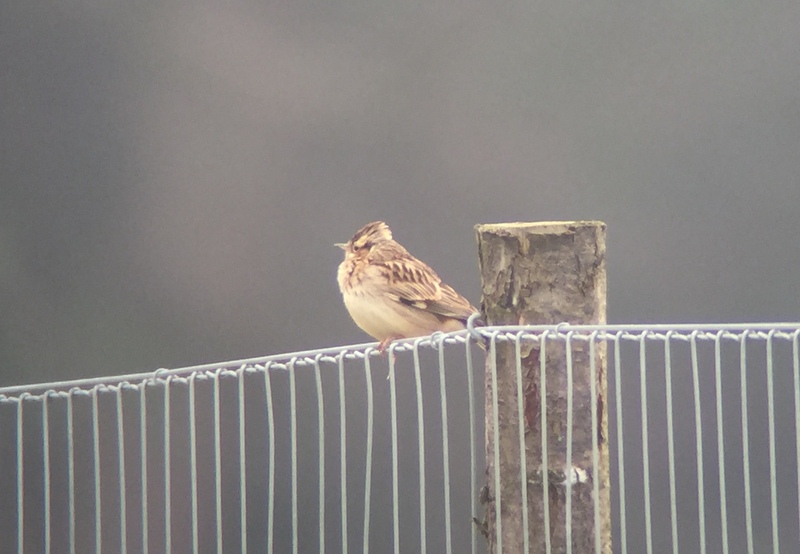 Woodlark – one of a pair on the fence briefly
Woodlark – one of a pair on the fence briefly
When the male Woodlark dropped down onto the ground too, we edged a little closer. We could see there were actually three Woodlarks together, feeding in and out of the furrows and in amongst the tree stumps and broken branches. A fourth flew in to join them and they split off into two pairs, eventually flying off in different directions. We could hear the male Woodlark singing as he flew, more mournful than the Skylark but still equally beautiful.
We waited a while in case a Goshawk might still appear, despite the mist which left a distinct chill in the air. However, the only bird to come up out of the trees was a female Sparrowhawk, which circled over the clearing, with bursts of rapid-fire wingbeats. It seemed unlikely that a Goshawk would be out here today, so we made our way back. As we drove back along the road, a line of Fallow Deer came running out of the trees and across the road, with two pure white ones bringing up the rear.
After an early lunch, we made our way round to Grime’s Graves. There has been a Great Grey Shrike around the area here on and off all winter, but it is very mobile and can be hard to track down at times. There had been no reports of it today, but we thought it was worth looking around its favoured clearings anyway. After we walked in through the trees, we stopped to scan the bushes and the first bird we set eyes on was the Great Grey Shrike, right on the very top of a quite tall young oak tree.
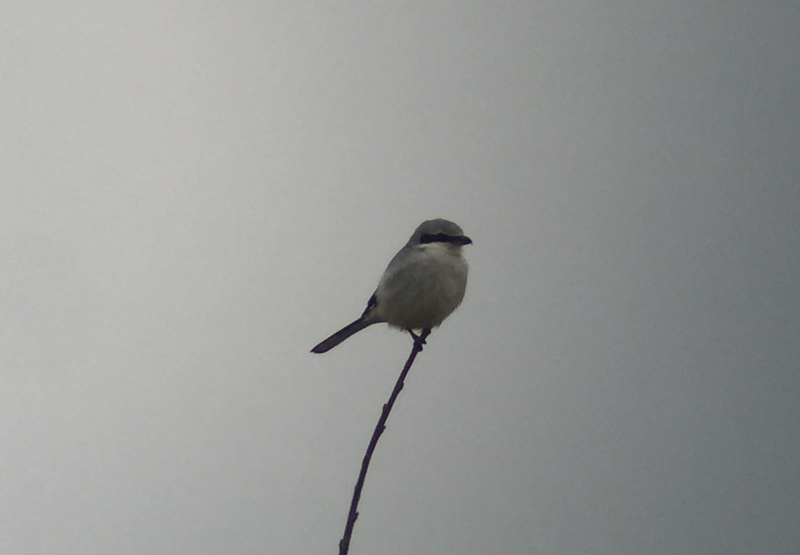 Great Grey Shrike – about the first bird we saw here this afternoon
Great Grey Shrike – about the first bird we saw here this afternoon
It was a little distant at first. Then suddenly the Great Grey Shrike took off and started to fly towards us, before stopping and hovering high up, above treetop height, out over the grass. It hovered for several seconds before flying over and landing on the top of another tree, this one rather closer to us. We had a really good look at it in the scope – noting its hooked bill. There it remained for some time – in the end, we decided to move on and leave it where it was.
We wanted to get to Lynford Arboretum in good time – with the cool and misty weather, it seemed like the Hawfinches might go into roost quickly today. We stopped by the gate for a quick look at the feeders first. The fat balls have been restocked and there was a lot of seed on the ground again today. The tits were taking full advantage of all the food, with a steady stream of Great Tits, Blue Tits and Coal Tits. A Nuthatch kept dropping down to the ground as well. We had enough time for a quick chat with the owner of the house here, before continuing on down towards the bridge.
There was lots of food put out for the birds on the fence posts and brick pillars of the bridges as well today. Here too, a variety of birds kept flying in to feed. The photographers in the group were keen to get some photos of all the activity, but we hadn’t been standing here too long before we heard a Hawfinch calling from one of the trees in the paddocks, the closest one to us. We walked down to the path on the other side of the lake and scanned the tree, but we just couldn’t see it from where we were standing. Then it flew out towards the lake.
We thought the Hawfinch might fly off up to the arboretum, but instead we could hear it calling from the trees a little further along the path in front of us. We didn’t want to walk along, in case we flushed it, but after creeping forwards a little, we managed to find it sitting in the back of the alders. We got it in the scope – not the best view, but a Hawfinch at least. Then someone came walking along the path towards us from the other end, and it was off.
Again, we assumed it would fly away, but this time we could hear it calling again from behind us. A quick scan and we found it perched in the top of the trees back beyond the bridge. Finally, a Hawfinch was perched out in the open and we had a really good look at it through the scope as it sat ‘ticking’ away. Then it flew off towards the paddocks again.
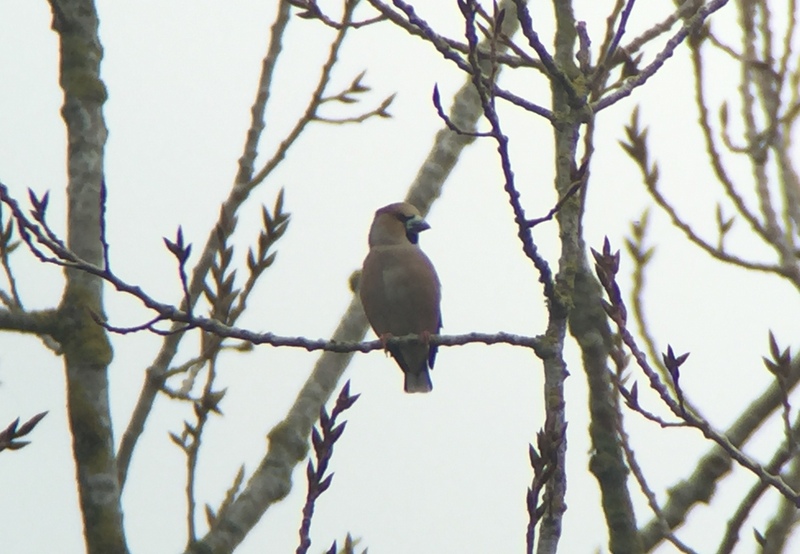 Hawfinch – finally came out into the trees by the bridge
Hawfinch – finally came out into the trees by the bridge
We walked round to the other side of the paddocks, just as a large group was leaving. They told us they had just seen six Hawfinches in the distant treetops behind the paddocks, but when we got there we could only see four of them. They dropped back out of view and it seemed like they might have gone off to roost early, until we heard one calling again in the paddocks. We were scanning the trees for it when there was a loud, deep ‘boom’, which reverberated around through the trees. The heavy artillery was starting up on the battle area! The birds all scattered and we just caught the back end of the Hawfinch as it dropped down into the pines.
After that, it seemed to go very quiet around the paddocks, bird-wise, even if we were treated to a succession of loud ‘booms’ of artillery fire, followed by the incessant rattle of machine guns. We walked back towards the bridge and resumed our attempts to photograph the birds coming down to feed there, which eventually seemed to recover from the shock and resume their normal activities. The tits were coming in from all directions – all the ones we had seen earlier, plus several Long-tailed Tits.
 Long-tailed Tit – picking seeds from the top of a post
Long-tailed Tit – picking seeds from the top of a post
The Marsh Tits seemed a little shy here today, but one eventually could not resist the lure of the food and gave itself up for the cameras.
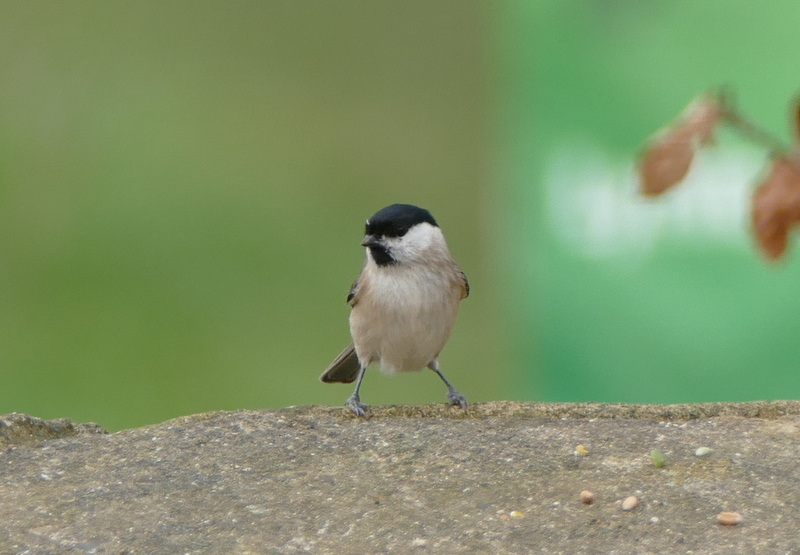 Marsh Tit – eventually showed very well
Marsh Tit – eventually showed very well
The stars of the show here were the Nuthatches, which kept coming in for more, before flying off into the wood to stash their food. A Treecreeper appeared in the trees by the bridge too.
 Nuthatch – kept coming back for more
Nuthatch – kept coming back for more
One of the group saw a flash of blue as a Kingfisher zipped round the island in the middle of the lake, so we decided to walk down that way along the path to investigate. There was no sign of the Kingfisher, but we were treated to great views of a Little Grebe diving out on the lake.
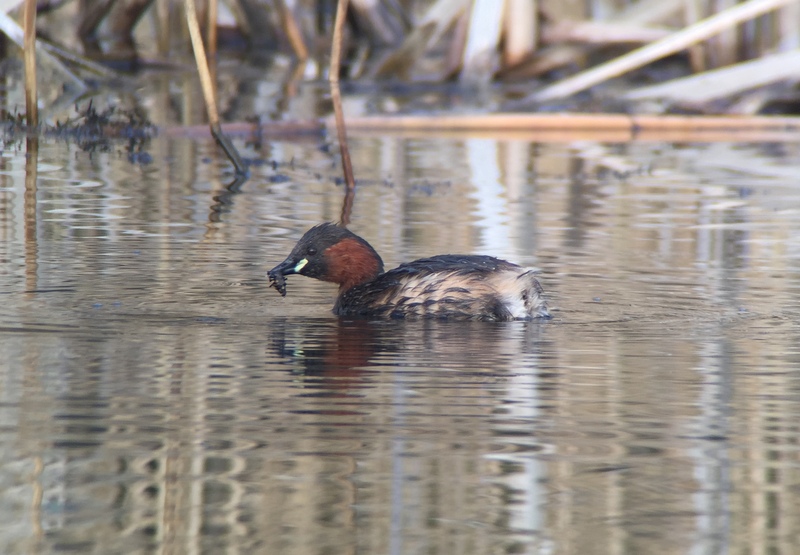 Little Grebe – diving for food on the lake
Little Grebe – diving for food on the lake
At this point, finally, the sun came out – only about 5-6 hours later than forecast! We were just thinking about making our way back to the car, when a last glance over at the trees way off the distance beyond the paddocks revealed two plump blobs in the top of one of them. We were looking straight into the light now, but a quick look through the scope confirmed they were Hawfinches. Given they often like to perch up in the afternoon sun, and no one had anywhere they needed to be in a hurry, we made our way back round the paddocks once again.
By the time we got round to the end of the paddocks, there was no sign of them there any more at first. However, from the other side of the pines we didn’t have to wait long before one Hawfinch reappeared. With the afternoon sun behind us now, we had cracking views of it through the scope, a female. We admired its huge nutcracker of a bill.
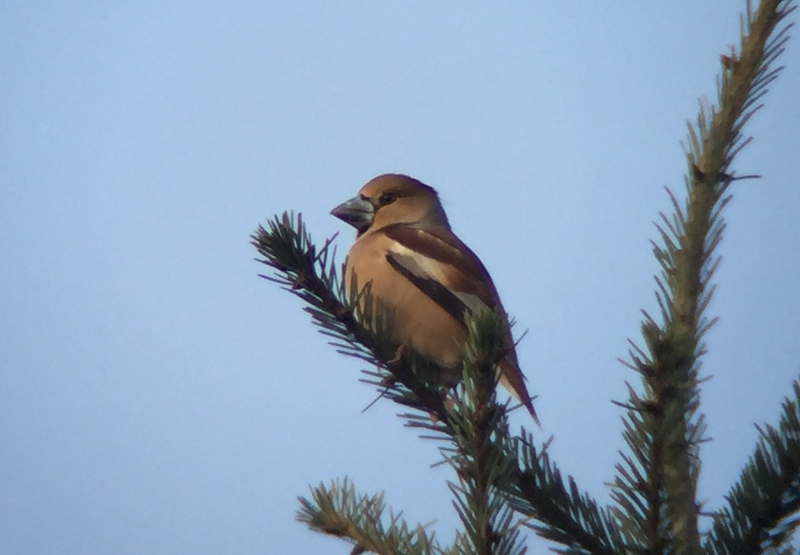 Hawfinch – lovely views in the afternoon sunshine
Hawfinch – lovely views in the afternoon sunshine
It perched in the tops in the sunshine for some time, then we heard another Hawfinch calling and it flew over to join it. We had to reposition ourselves to see them – this time we could see a brighter coloured male too. When they flew again, we discovered there were actually three together now. They kept flying round between the treetops for a bit, but when they dropped down again out of view, we decided to call it a day and head for home. It was a great end to the day – watching the Hawfinches flying round and perching up in the sun.
















